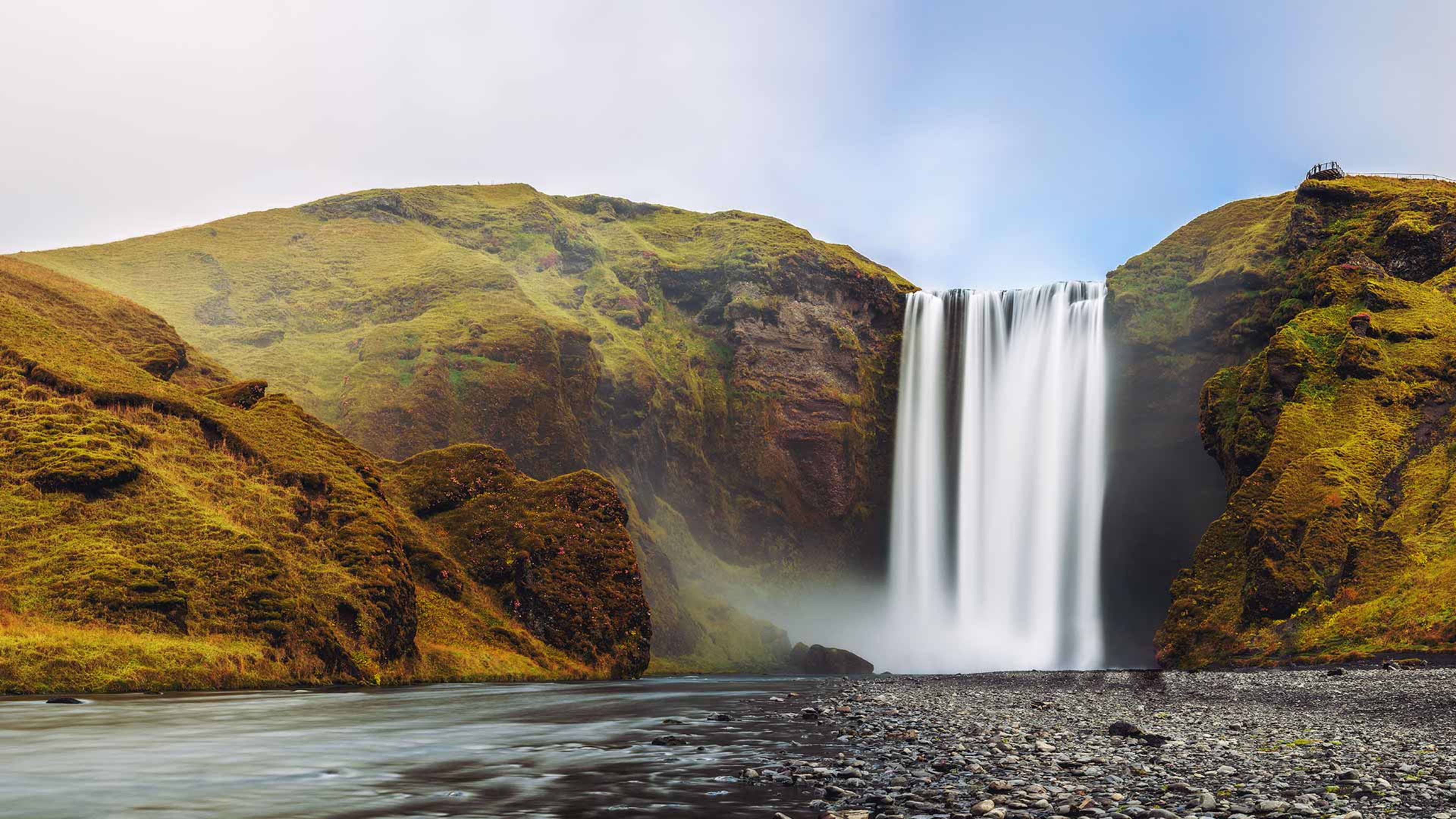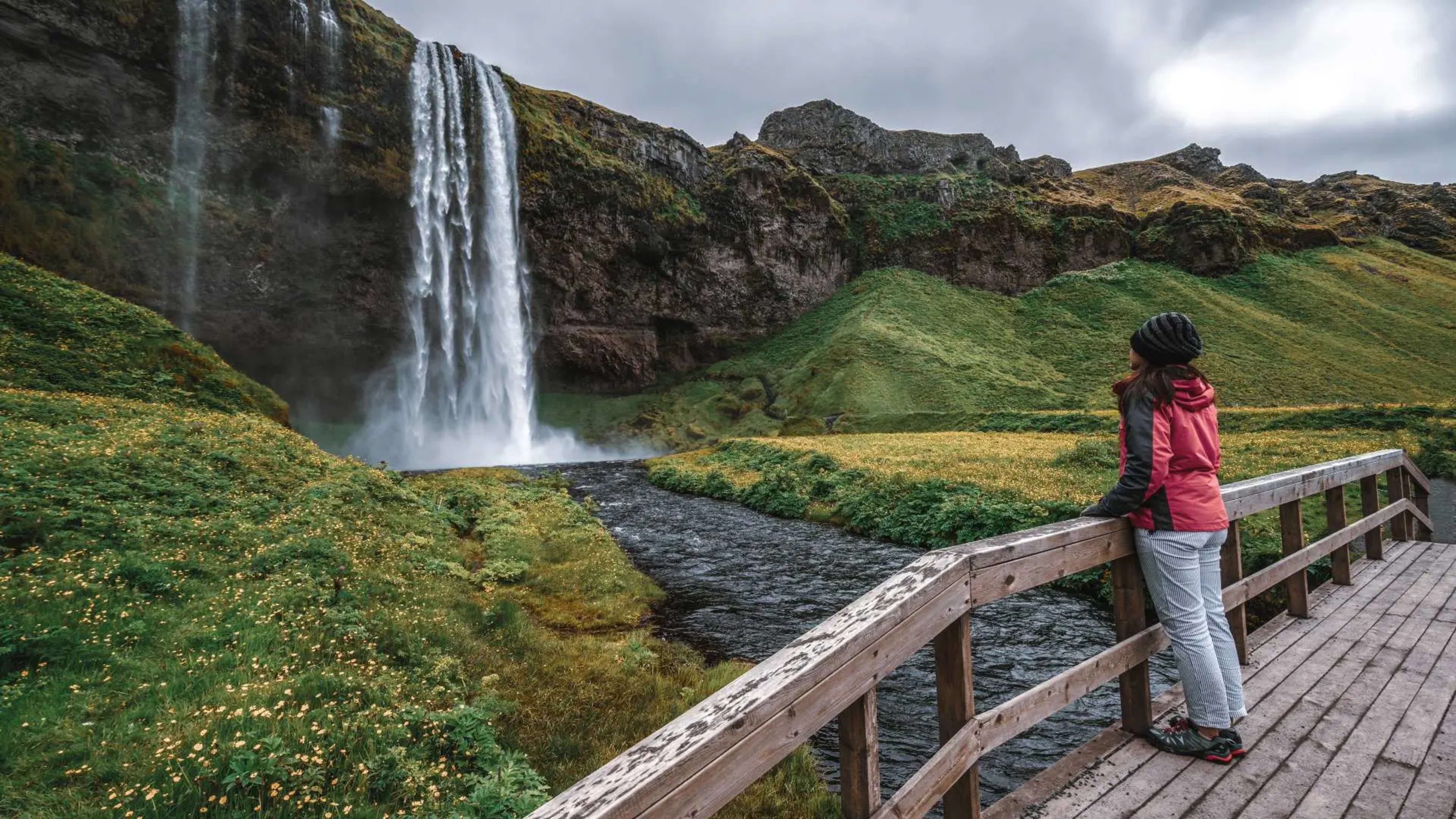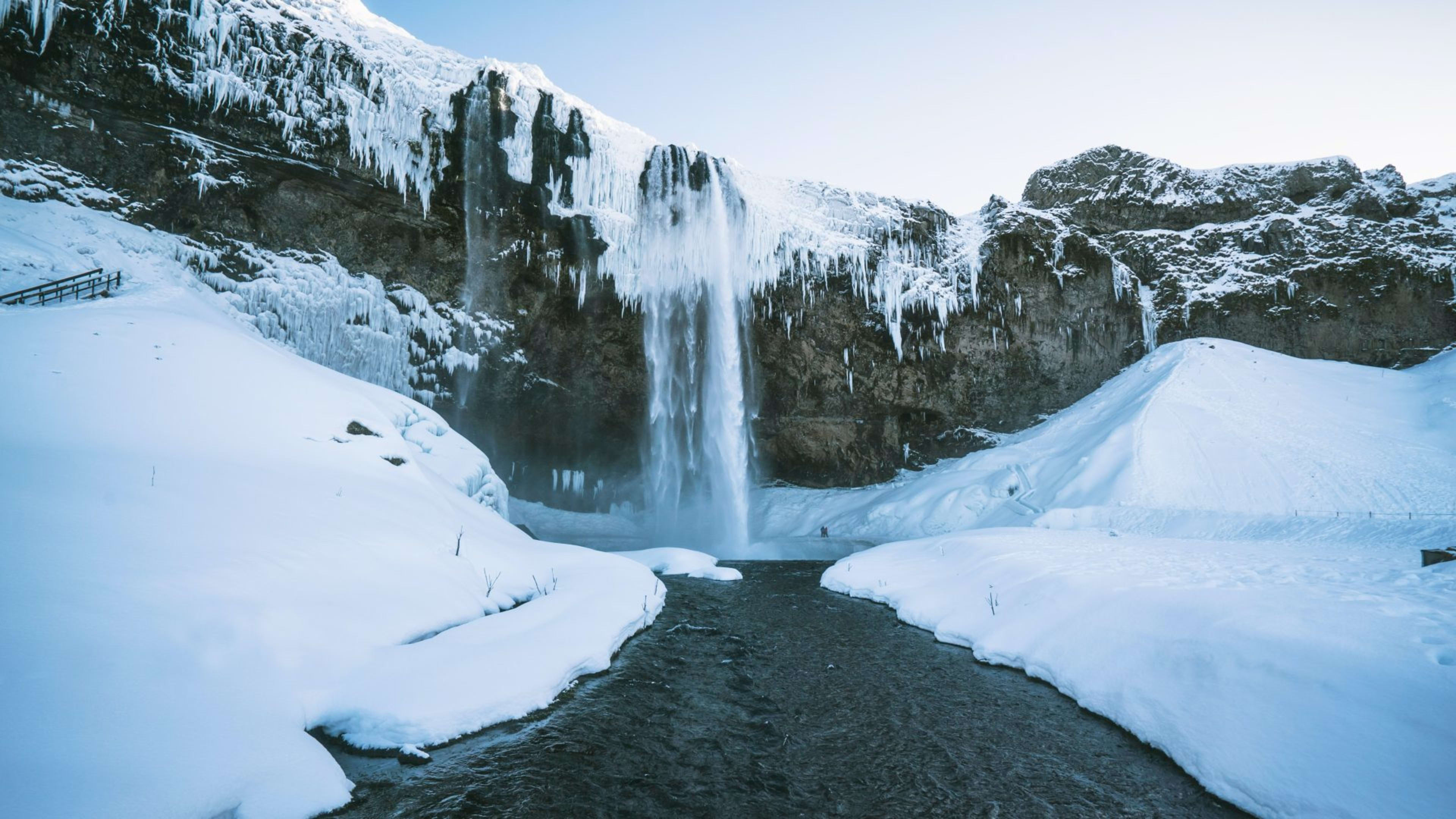Of all the natural wonders to see in Iceland, waterfalls have gotta be near the top of your list! The country is quite literally laced with them, so they’re pretty hard to miss. But which waterfalls in Iceland are the best to see?
Here we’ve rounded up some of our favorites for you. We’ve even put them on an Iceland waterfalls map, so you can easily find the location of these watery wonders.
What might surprise you is just how diverse Iceland’s waterfalls are. At Seljalandsfoss, you can walk behind a curtain of water as it tumbles down. Then there’s Svartifoss, which is enclosed by hexagonal columns of basalt.
You could also see Dynjandi, which resembles a bridal veil, as it cascades gently down toward the sea. Or check out Barnafoss and Hraunfossar, a whole set of waterfalls centered on the point where dozens of streams merge together.
So read on and get the lowdown on the best waterfalls in Iceland.
- Get your fill of waterfalls on one of these Iceland self-drive tours.
Iceland waterfalls map
When planning your trip to Iceland, it makes sense to figure out where in the country the main attractions you want to see are. Waterfalls are up there with the best of what Iceland has to offer, along with glaciers, hot springs, the Northern Lights, and more.
Iceland’s waterfalls come in all shapes and sizes. Some of the smaller waterfalls, like Kirkjufellsfoss, are incredibly charming – particularly on a bright day when the sun glistens in the water. At the other end of the spectrum are the heavyweights like Gullfoss and Dynjandi, which pack a punch with their sheer might.
On this map, we’ve pinned 12 of Iceland’s waterfalls that we think you’ll be blown away by:

Keep on reading to find out how to get to these waterfalls and learn what’s unique about each and every one.
- Want to see the Aurora Borealis? Check out these Northern Lights trips.
- Travel Guide: Introduction to Iceland’s nature & landscape.
Top waterfalls in Iceland
1. Gullfoss
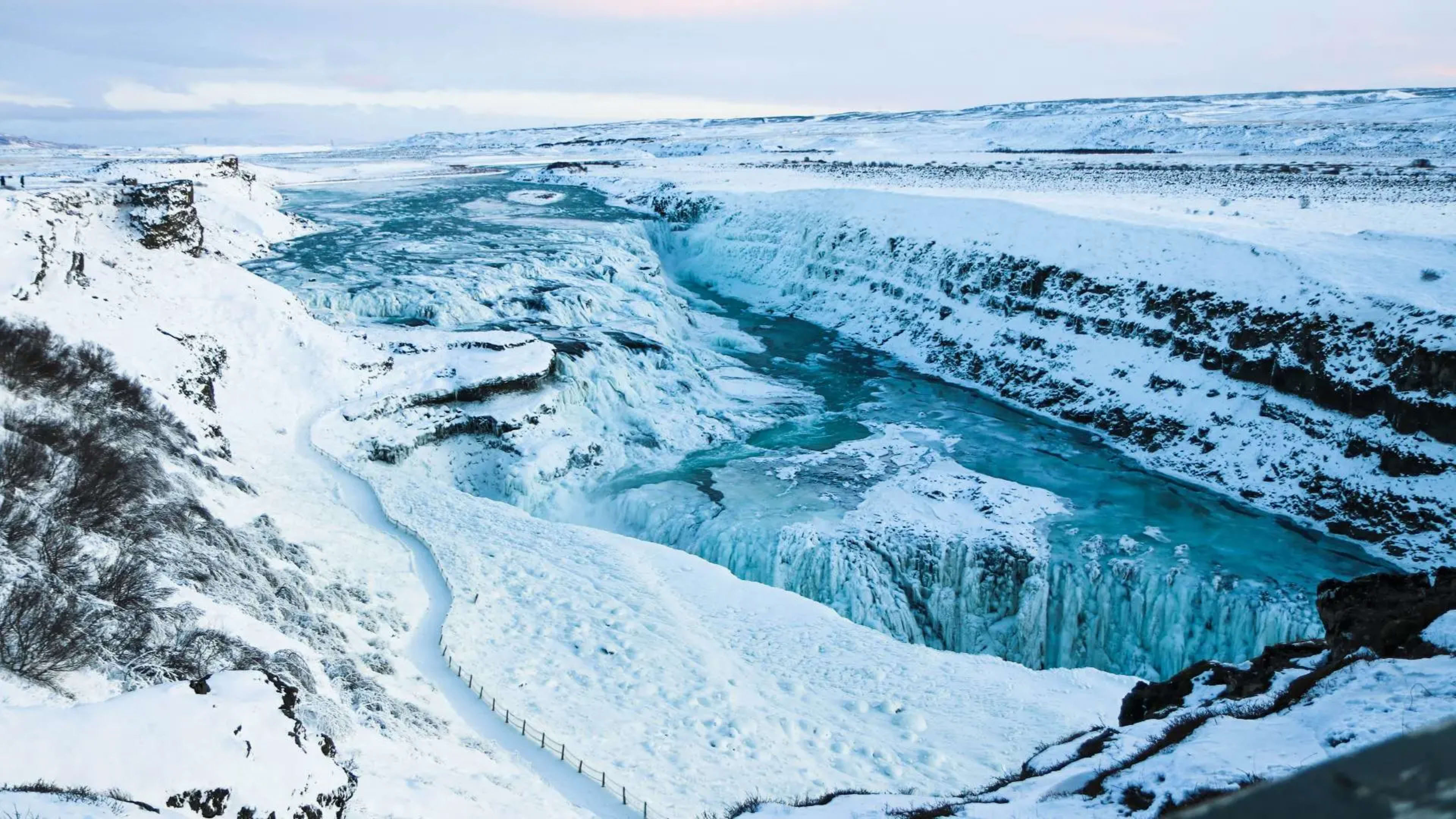
Location: Golden Circle, South Iceland
Let’s start with Gullfoss (‘Golden Falls’), the jewel in the crown of Icelandic waterfalls. In fact, it’s so famous that it lent its name to the much-loved Golden Circle touring route.
Sitting on the Hvítá river, the Gullfoss waterfall is spread across several cascades with drops of different heights.
The first big drop is around 11 meters (36 feet), while the second is much deeper at 32 meters (105 feet). This creates a thunderous, roaring sound and clouds of water spray, where you can see rainbows on a sunny day!
Gullfoss looks even more dramatic by winter than it does by summer. Parts of the waterfall can freeze over, creating thousands of icicles. Set against the snowy landscape, and with the Langjökull glacier just over the horizon, a wintry Gullfoss makes for an unforgettable Icelandic scene.
You’ve got a choice of 2 walking routes from the upper or lower parking lots. At the upper parking lot, there’s also a visitor center and café, perfect for warming up over a hot chocolate after marveling at Gullfoss.
- Check off all the sights of the Golden Circle on a guided group tour of Iceland.
2. Seljalandsfoss
Location: Route 1, South Iceland
As you drive the Ring Road along the south coast of Iceland, Seljalandsfoss gradually comes into view. From a distance, it looks like a white line drawn on the mountainside. But when you get closer, you can see just how magical it is!
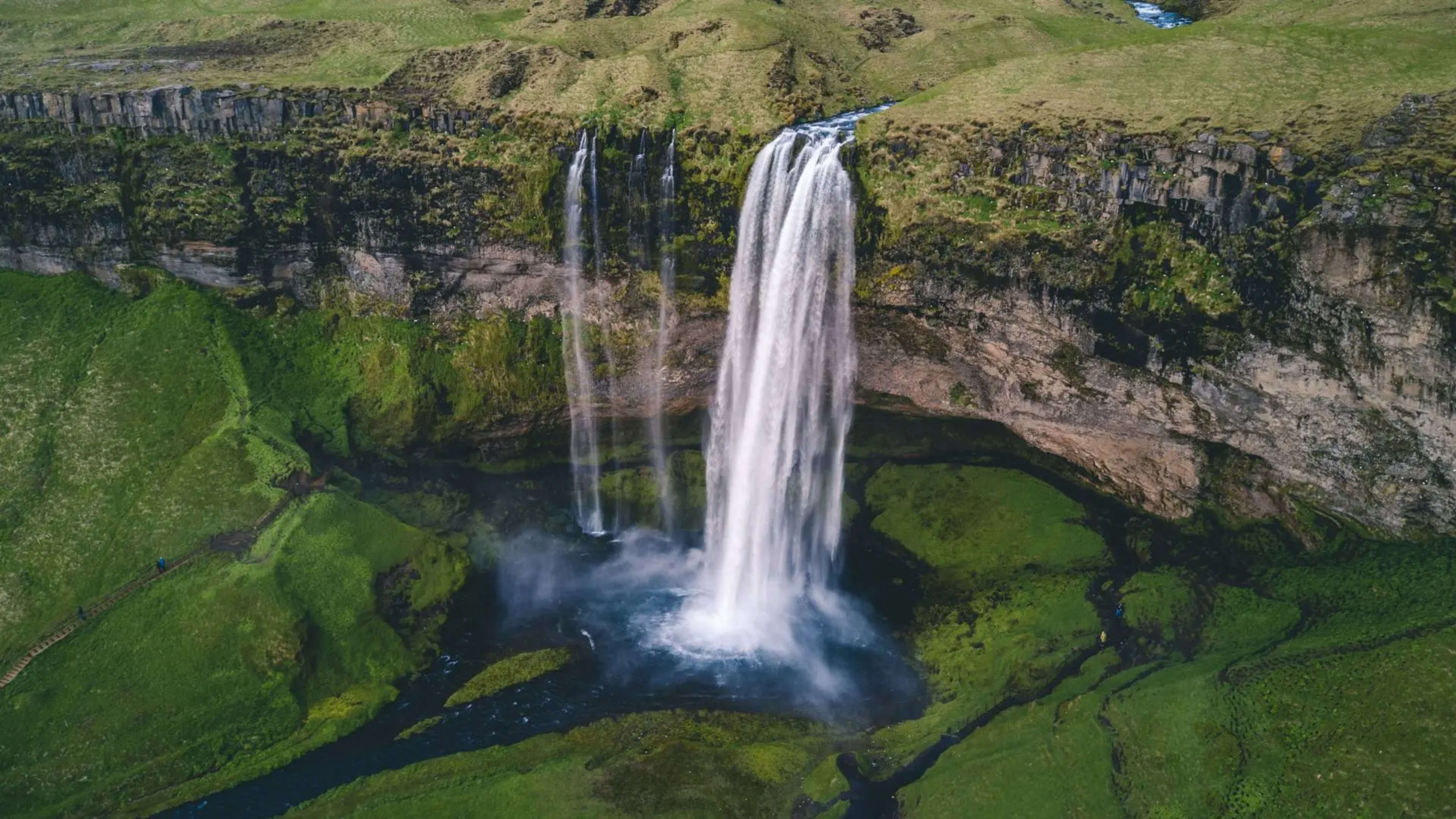
Seljalandsfoss is best known for the fact that you can walk behind it. Follow the walking path up a few steps and you arrive in a cavern, carved out in the rock behind the plume. Feel the mist on your face and breathe in the fresh scent of moss.
This waterfall is spectacular in wintertime because it freezes relatively easily. The spray given off by the tumbling water turns into solid hunks of ice around the base of the falls, whilst the top is frosted with delicate icicles.
If you have a bit of extra time, there’s a bonus waterfall a 5-minute drive away. Gljúfrabúi is a true hidden gem, concealed in its very own canyon that you can glimpse into. To get to this 40-meter (130-foot) waterfall, you need to wade in some shallow water, so bring your rubber boots if you want to check this one out!
- Marvel at the icy glory of Seljalandsfoss on an Iceland winter self-drive trip.
- Related: Things to see and do near Reykjavík.
3. Skógafoss

Location: Route 1, South Iceland
Around half an hour’s drive further south from Seljalandsfoss is its bigger brother Skógafoss (‘Forest Waterfall’). At 60 meters (200 feet) tall and 25 meters (80 feet) wide, Skógafoss tumbles over what used to be a sea cliff.
This waterfall gives off a lot of spray, meaning that you can pretty reliably see rainbows there on a sunny day. If you want to get close enough to taste the mist on your tongue, take a walk along the flat pebbly beach next to the river the waterfall flows into.
For a view from above, follow the hiking trail up the eastern side of the waterfall. Once you reach the top, you’ll see jaw-dropping views of Skógafoss itself and the sea in the distance.
- Visit Skógafoss in the summer on a camping trip in Iceland.
4. Dettifoss

Location: North Iceland
The Dettifoss waterfall is located in the Vatnajökull National Park in northern Iceland. Although it’s not one of the tallest waterfalls in Iceland, it’s considered a beast thanks to its sheer might. Dettifoss is the second most powerful waterfall in Europe.
Dettifoss is much wider than it is tall. It spans 100 meters (330 feet), but the drop is only around 45 meters (145 feet). The waterfall is fed by the meltwater that runs off Iceland’s largest glacier, Vatnajökull.
If you’re planning to check out the other delights of North Iceland, like the charming town of Húsavík or otherworldly nature of the Lake Mývatn area, then add a stop at Dettifoss to your itinerary.
- Discover the delights of North Iceland on a private tour.
5. Svartifoss

Location: Skaftafell, Vatnajökull National Park, southeast Iceland
Now for something a bit different. Svartifoss (‘the Black Waterfall’) is one of Iceland’s most instantly recognizable waterfalls thanks to the dark, hexagonal basalt columns that surround it.
These columns were formed about 300,000 years ago when molten lava cooled down rapidly and crystalized, similar to the Giant’s Causeway in Northern Ireland. At Svartifoss though, the lava ran down an old riverbed. Eventually the water returned, creating the waterfall you see today!
Svartifoss is around 1 hour’s hike from the parking lot at the Skaftafell Visitor Center in the Vatnajökull National Park in southeast Iceland.
- See Svartifoss and more delights on a 5-day trip to Iceland.
- Read our Travel Guide for more on Iceland’s nature & landscape.
6. Dynjandi
Location: Westfjords
It’s hard to know whether Dynjandi should count as just one waterfall, or several strung together. Technically, Dynjandi only refers to the largest cascade at the top of this set of falls.
You’ll find it easy to recognize, as it resembles a lace bridal veil draped over the mountainside. The waterfall is located in a fjord called Arnarfjörður, just off the 60 road that hugs the coastline of the Westfjords.

To reach Dynjandi, take a short walk up the hiking trail from the car park. On the way up, you’ll pass a series of small waterfalls. Each has its own charm, and its own name. And there’s just too many to list here!
- Related: Ultimate guide to the Westfjords.
7. Barnafoss & Hraunfossar
Location: West Iceland
This set of twin waterfalls has to be one of the most awe-inspiring sights in Iceland. Both Barnafoss (‘Children’s Waterfall’) and Hraunfossar (‘Lava Falls’) run into Hvítá (that’s the same river as Gullfoss). Because it’s a glacier river, the water is a bright, almost glowing, blue color.
What makes Barnafoss stand out is the unusual geology surrounding it. It gushes through a narrow, twisting canyon underneath a natural rock bridge. But don’t try to cross the bridge, it’s definitely not safe.

There’s a folk tale about a second natural rock bridge across the falls. Long ago, at Christmastime, there was a family of farmers who lived on one side of the river. One day, the parents used the rumored second bridge to cross over the falls on their way to church.
The parents had left their two boys behind at the farm, who decided to follow in the churchgoers’ footsteps out of boredom. The story goes that the boys fell into the falls and perished, and that the farmer’s wife had the bridge torn down soon afterward.
Today, you can safely peer into Barnafoss from the observation decks and walking trails that criss-cross the area.

As you walk up to Barnafoss, you’ll pass Hraunfossar. This is a set of countless small streams that run off the Hallmundarhraun lava fields, over a cliff edge, and into the Hvítá river. The result is stunningly beautiful!
8. Hengifoss
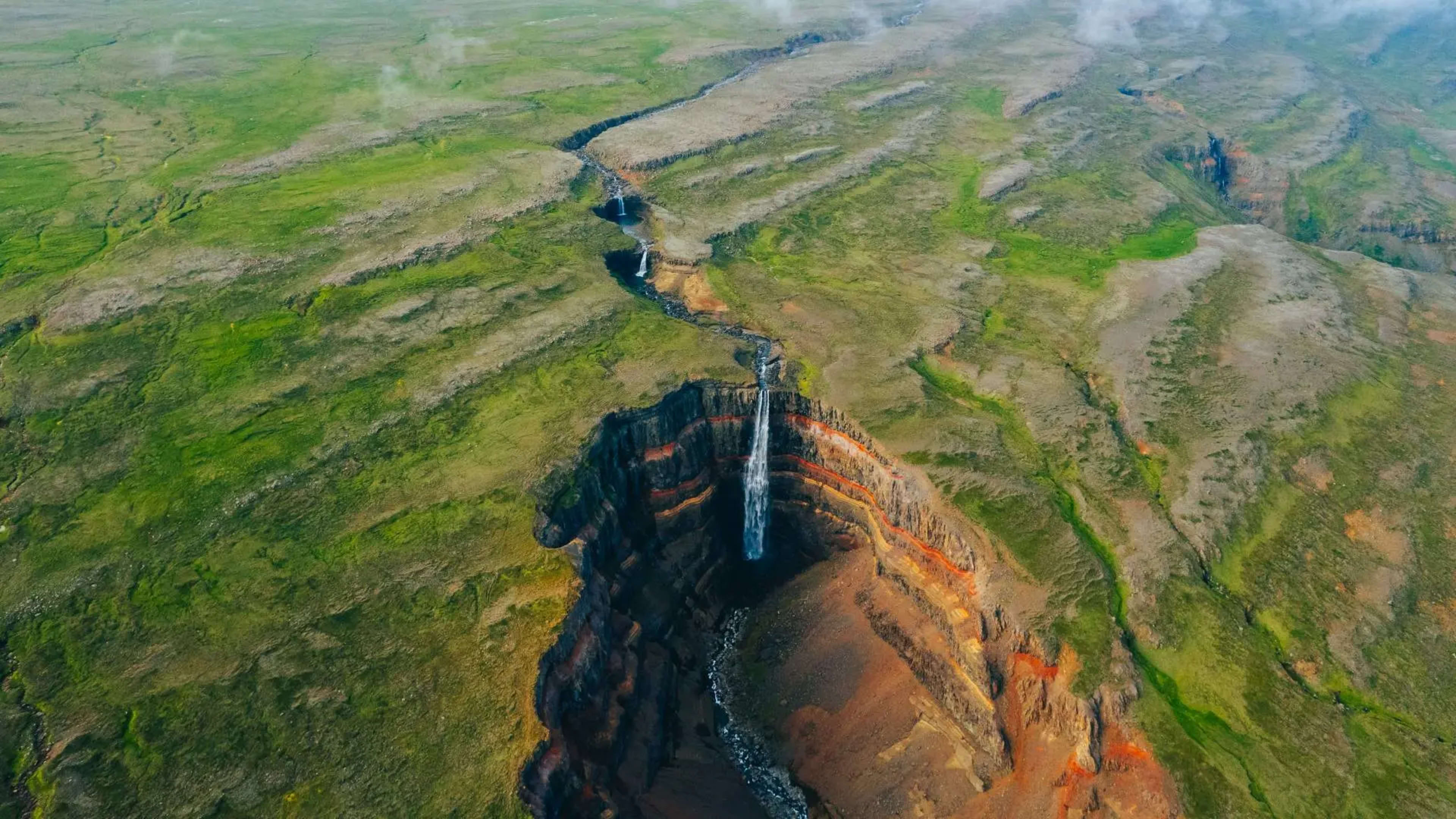
Location: East Iceland
Thanks to its location in the lesser-visited East Iceland, the Hengifoss waterfall is definitely off the beaten path. It runs into the Fljótsdalur valley, at the end of the Lagarfljót river.
At 128 meters (420 feet) tall, Hengifoss has an impressive drop over the edge of a pitch-black cliff. The rockface is broken up with striking horizontal stripes of red. The whole thing is hidden away in a secluded canyon, about a 2-hour walk from the parking lot.
Although it takes a fair bit of effort to get there, the payoff is incredible. As you stand at the foot of this giant plume of water, you’ll get a feeling for just how powerful nature can be.
Hengifoss is located off the 931 road, which connects up to Route 1 (the Ring Road). As you drive there from Egilsstaðir, the nearest town, you’ll pass the Hallormsstaðaskógur forest, the largest in Iceland. The scenery in this whole area is truly epic, and well worth the detour.
- See even more waterfalls on an Iceland Ring Road trip.
- Related: Your guide to car rental in Iceland.
9. Kirkjufellsfoss

Location: Snæfellsnes peninsula
Kirkjufellsfoss on the Snæfellsnes peninsula is probably one of Iceland’s most photographed waterfalls. But it’s not one of the biggest or jaw-droppingest, so why is it so popular? The answer is the famous Kirkjufell mountain, which can be seen in the background of almost any pic of the waterfall!
Feel like you recognize that distinctive pointy peak? Kirkjufell was used as a filming location for ‘arrowhead mountain’ in Game of Thrones.
Kirkjufellsfoss itself is very accessible thanks to its location just off the 54 road, the main coastal route around the Snæfellsnes peninsula. It’s only a 2-minute walk from the parking lot along a gently sloping path.
If you want to snap your own version of the famous Kirkjufellsfoss pic, the best location is across the bridge, from the far side of the river. But we think the waterfall is charming in its own right, so feel free to explore the whole area.
10. Goðafoss
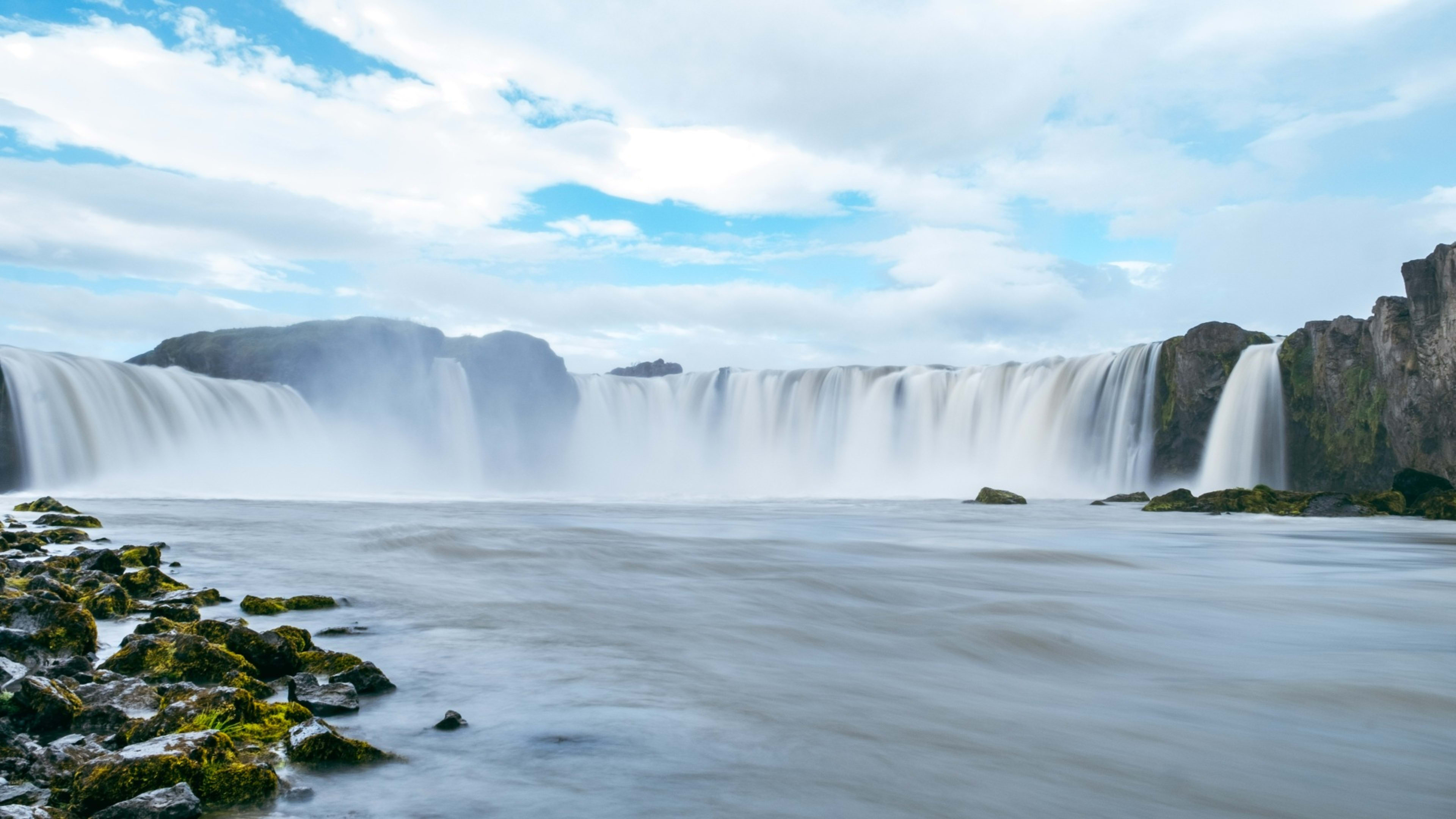
Location: North Iceland
Goðafoss is a pearl of northern Iceland and one of the most powerful waterfalls in the country. The name can be interpreted as ‘Waterfall of the Gods’, but the legend of the name’s supposed origin is just as interesting!
In Viking times, Iceland was ruled by local chieftains known as goðar. They were Pagans, sometimes running temples and leading religious ceremonies.
The local chieftain in this part of the country was a man named Þorgeir Þorkelsson. At a session of the Alþingi at Þingvellir, Iceland’s ancient parliament, Þorgeir decided that all Icelanders would become Christians. When he returned home north, he cast his Pagan idols into the waterfall. After this, the waterfall is said to have been called ‘Waterfall of the Goðar’.
Although the story of Þorgeir’s attendance at the Alþingi is written down in the Sagas of Icelanders, there is no record of him throwing his idols into the falls. Whether or not it’s true, Goðafoss has an impressive majesty about it that will hopefully inspire awe in you too!
- Read more about the sagas in our guide to Iceland’s people & culture.
11. Glymur
Location: Hvalfjörður, near Reykjavík
Despite being just over 1 hour’s drive from central Reykjavík, the Glymur waterfall is something of a hidden gem. It sits right at the end of the Hvalfjörður fjord. Thanks to a tunnel that crosses the other end fjord, many people skip driving around it and miss out on Glymur.

Glymur long held the title of Iceland’s tallest waterfall, at 198 meters (650 feet) high. That all changed in 2007 though, when the Morsárfoss waterfall was discovered in Vatnajökull National Park.
If you want to visit Glymur, you should be prepared for a bit of a hike. The walk to the waterfall takes around 2 hours from the nearest parking spot. You should take care near the steep cliff edges. If you have a fear of heights, you might prefer to stick to some of the more accessible waterfalls listed above.
12. Faxi
Location: South Iceland, near Gullfoss
As you may have realized by now, foss means ‘waterfall’ in Icelandic. Along with Glymur, Faxi is one of only a handful of Icelandic waterfalls whose name doesn’t end in foss. Its name means ‘mane’.
If you plan on a Golden Circle tour, it’s easy to add a stop-off at Faxi. It’s only around 12 km (8 miles) from Gullfoss and the Geysir hot spring. So why not squeeze another wonderful waterfall into your itinerary?

Some people describe Faxi as a mini version of Gullfoss. It’s very wide, but only has one tier, unlike its big brother. And Faxi less popular to visit as it’s slightly off the beaten path, so if you don’t like the crowds this is a great waterfall to see.
Faxi is on the Tungufljót river, which is chock-full of salmon. Next to the waterfall is a salmon run, a ladder-like structure that allows the fish to make their way upstream to lay their eggs.
Book your Iceland waterfall trip
So now you’ve had the lowdown on all the best waterfalls in Iceland. And there’s plenty more than we’re able to list here!
If you only want to see the main waterfalls, you could go for a multi-day tour from Reykjavík. On this kind of tour, you’ll travel by bus and see hits like Gullfoss, Seljalandsfoss, and Skógafoss.
But if you want to visit all the waterfalls on this list, a self-drive tour of Iceland is the best option. With a car, you have the freedom to go where and when you please, so you might even discover some more for yourself!
Go on, why not start planning your Iceland waterfall adventure today?


